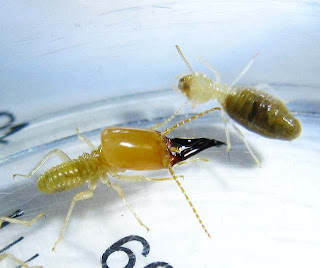This Microcerotermes species have soldiers whose head are very rectangular with shorter, thicker mandibles than the more commonly found species. The nest is similar to those of the common species and are found on the side of tree trunks not to far up from the ground. These termites do not appear to do serious damage to the trees on which they nest as they feed only on dead wood. The entire nest may sometimes drop off the trees many many years later after the nest loose all the resident termites. The most common species of this termite genus in this location is Microcerotermes crassus. Microcerotermes termites usually nest on the main trunks of trees. Their nests are made of chewed wood and excrement.
Workers and soldier of Microcerotermes serrula.
A Microcerotermes serrula soldier, reproductive nymph and workers
The soldier of a Microcerotermes serrula.
Microcerotermes serrulla soldier.
A soldier of Microcerotermes.
Reproductive nymphs, workers and soldiers of Microcerotermes serrula.
Workers of Microcerotermes.
Close-up of a termite worker of Microcerotermes.
A nymph of the reproductive caste of the termite Microcerotermes.
Close-up of a soldier and worker of Microcerotermes serrula.
See also:
Microcerotermes crassus
Microcerotermes biroi.
Taxonomy:
Top Node: Cellular organisms 131567
Superkingdom/Domain: Eukaryota 2759
(Unrank) Opisthokonta 33154
Kingdom: Metazoa 33208 (Fungi/Metazoa group)Microcerotermes crassus
Microcerotermes biroi.
Taxonomy:
Top Node: Cellular organisms 131567
Superkingdom/Domain: Eukaryota 2759
(Unrank) Opisthokonta 33154
(Unrank) Eumetazoa 6072
(Unrank/Subkingdom) Bilateria 33213
(Unrank) Coelomata 33316
Branch: Protostomia 33317
(Unrank) Ecdysozoa 1206794
Superphylum: Panarthropoda 88770
Phylum: Arthropoda 6656
(Unrank) Mandibulata 197563
(Unrank) Pancrustacea 197562
Superclass: Hexapoda 6960
Class: Insecta 50557
(Unrank) Dicondylia 85512
(Unrank) Pterygota 7496
Subclass: Neoptera 33340
Infraclass: Orthopteroidea 33341
Superorder: Dictyoptera 6970
Order: Blattodea 85823
Infraorder: Isoptera 7499 (this has been reassigned as Infraorder placed under the order Blattodea)
Family: Termitidae 46569
Subfamily: Termitinae 92738
(Unrank) Amitermes group (Amitermitinae/Amitermitidae) 377823
Genus: Microcerotermes 139992
Species: serrula 187518
First Posted: 2011 03 24
© 2011 - 2013 Quah. All rights reserved.


































